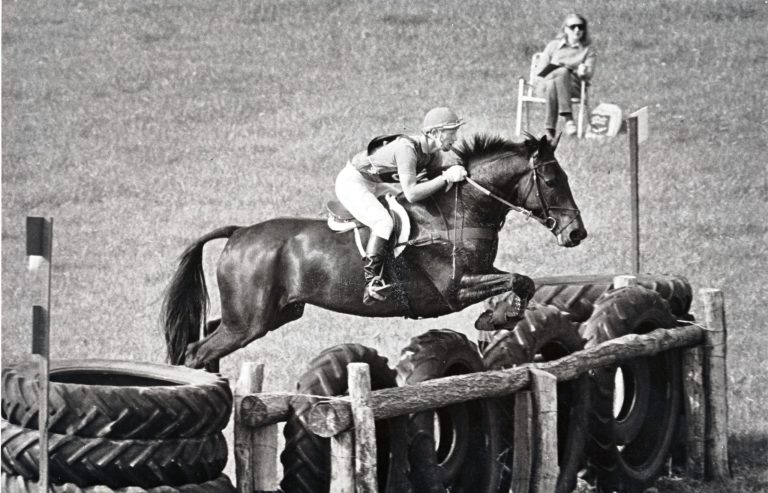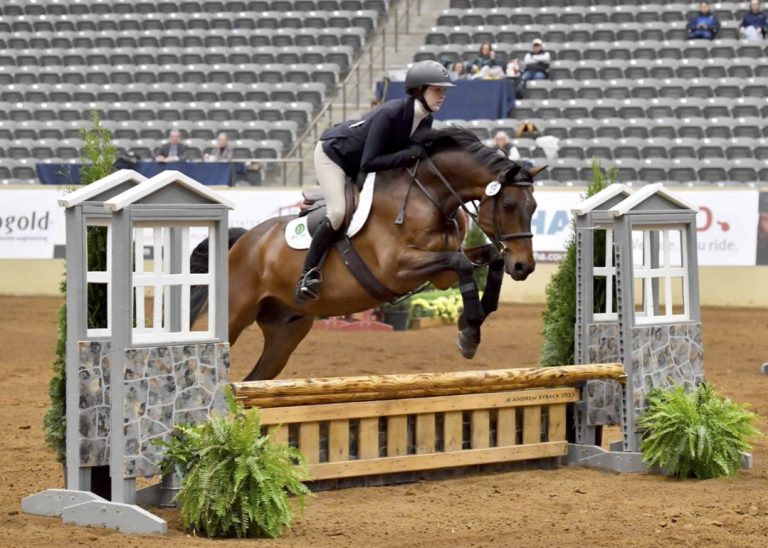 Jennifer Gates and Saskia at the 2015 George H. Morris Horsemastership Training Session | © Megan Stapley Photography
Jennifer Gates and Saskia at the 2015 George H. Morris Horsemastership Training Session | © Megan Stapley PhotographyAs I woke hastily to my 5:30 a.m. alarm, I felt invigorated and excited for the adventure to come but also a little nervous. I was one of 12 young riders selected for the five-day 2015 George H. Morris Horsemastership Training Session. In addition to daily riding lessons from this legendary rider and trainer, we would learn about stable management, veterinary care, sport psychology and course design from top professionals in Wellington, Florida. Going into it, I knew I had less experience than many of the other riders.
Though we didn’t have to be at the stable until 6:30 a.m. to feed and do barn chores before the first morning riding session with George, I arrived more than 30 minutes early. It was my first time at this prestigious clinic, and I wanted to make sure I was not rushed. Walking into the barn, I searched everywhere for the lights to no avail, so I pulled up to the barn aisle and left on my vehicle lights. As my fellow trainees arrived, they greeted me with giggles and amusement at my unconventional light source.
My daily routine began by putting a halter on my lovely 12-year-old Oldenburg mare, Saskia, and pulling her out of the stall so I could muck. Although she is an amazing horse, she doesn’t like people in her space and I didn’t want to risk getting kicked. In my enthusiasm, I overmucked each day and added extra shavings just to make sure Saskia was comfortable. After that, she greeted me with lots of nickering as I brought the hay to her stall. Next, we checked in with Colleen Reed, the barn manager, to make sure the work was up to George’s high standards, and then the first group of six riders began to get their horses ready. I was in the second group so I had the chance to watch and prepare.
I was amazed by the simplicity and effectiveness of all the lessons. The basic principle of getting the horses in front of the riders’ legs and not walking like “constipated cats,” as George described, helped the horses become more supple through their polls and more relaxed overall. Working from the impulsion created by the hind legs also helped the riders not use too much hand or try to “seesaw” the bit. Keeping the outside rein and inside leg helped to straighten the majority of the horses as they worked on their lateral exercises. As the flatwork progressed to over fences later in the week, I appreciated watching riders improve dramatically after small comments from George about letting the horse jump the jump. These are all concepts my trainers have emphasized over the years, but seeing them in action with these top riders helped me understand and appreciate them in a new way.
Each day I relaxed a little more as I walked into the ring to warm up my mare. Saskia is brilliant with wonderful flatwork and a heart of gold. Over fences, she helped me learn the principle of continuing to go forward by jumping her best when I had pace and impulsion even if I didn’t see the perfect distance. Despite the 85-degree temperatures and intense atmosphere of working with a legend such as George, I felt a sense of peace and connection with my horse take over and I was able to focus on learning as much as possible.
By the end of the five days, I had learned an immense amount, even through my mistakes and mishaps. The experience was a powerful reminder that to improve, we have to put ourselves in uncomfortable situations. I was out of my comfort zone the entire week, but I cherished every second. I am extremely grateful to all of the clinicians and sponsors who give their time and resources to help develop and strengthen young U.S. riders for the future.
Jennifer Gates, 19, of Seattle, Washington, won a team gold medal at the 2014 North American Young Rider Championships. She also placed first in a 1.30-meter Open Classic at the Thunderbird Show Park, second in the 2014 Las Vegas National $30,000 Speed Class and second in The Hollywood Reporter Trophy Class (1.45-meters) at the 2014 Longines Los Angeles Masters. She filled one of six wildcard spots at the George H. Morris Horsemastership Training Session.
This article originally appeared in the June 2015 issue of Practical Horseman.










